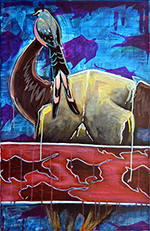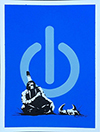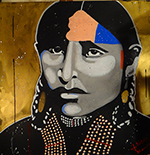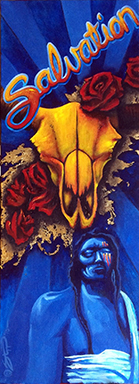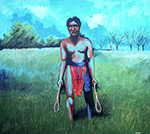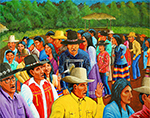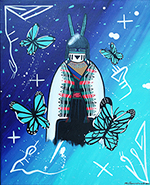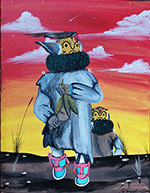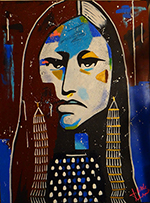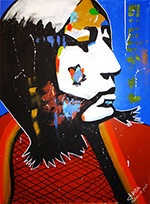Ancient Visions and Contemporary Voices: Paintings from Indian Country
Celebrate Native American Heritage Month with an exhibit featuring works by Johnnie Lee Diacon (Creek), Bj Stepp (Cheyenne/Cherokee), J. NiCole Nahmi-A-Piah Hatfield (Comanche-Kiowa), and Kai Humeyestewa (Hopi).
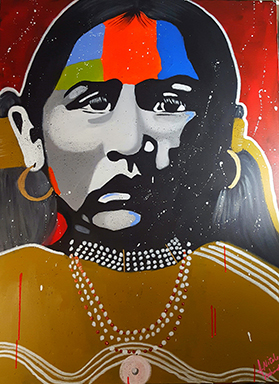
Johnnie Lee Diacon is a member of the Mvskoke (Creek) Nation of Oklahoma, the Raprakko Etvlwa (Thlopthlocco Tribal Town), and the Ecovlke (Deer Clan). Daicon studied the Traditional style of Indian painting and mural painting at Bacone College in Muskogee, Oklahoma under Ruthe Blalock Jones. Most of his traditional works are spiritual and ceremonial depictions in the Bacone School, or Flatstyle of Indian art in tempera and gouache on illustration board or watercolor paper, or in acrylic on stretched canvas. Diacon also studied art at Northeastern State University in Tahlequah, Oklahoma and the University of Arkansas in Fayetteville, and the Institute of American Indian Arts in Santa Fe, New Mexico. Johnnie's contemporary style of work is usually either acrylics or oils on gessoed board or stretched canvas. These works often depict some of the secular life ways of modern Native Americans, including the artist's involvement with the American Indian Movement and Idle No More.
Kai Burton Humeyestewa (Kuk Tut Wa), from Kykotsmovi, Arizona, is a member of the Coyote Clan of the Hopi. Humeyestewa is a senior at Hopi High School and is a self-taught artist whose style is influenced by the late Duane Dishta, a well-known Zuni artist. Kai earned the 2016 Heard Museum Guild first place prizes for painting and turquoise jewelry.
J. NiCole Hatfield (Nahmi-A-Piah) is of the Penetukah (honey eater) band of Comanches with ties also to the Kiowa. Largely self-taught, Hatfield attended the Institute of American Indian Arts in Santa Fe, which developed her use of different mediums. Hatfield draws her inspiration from old historical photographs of proud tribal women. She says that in painting them, she honors them by giving them a voice in our contemporary world. She frequently incorporates tribal language into her paintings to teach as well keep Native languages alive. Read more on her website at www.jnicolehatfield.com.
Bj Stepp, Jr., has family ties to the Red Moon community of the Southern Cheyenne nation and the Oak Ridge community of the Cherokee nation. Stepp received his AFA from the Institute of American Indian Arts in Santa Fe, New Mexico and studied two dimensional studio arts at Southwestern Oklahoma State University in Weatherford Oklahoma. After years of artistic growth and development, Stepp says he is just beginning to find his identity as a painter representing his Cheyenne and Cherokee families, his home state of Oklahoma, and the artists and people whom have inspired and encouraged his pursuit of art.
As the title for the exhibit implies, the artists bridge the gap between traditional and contemporary art in their respective works. Hatfield acknowledges the challenge of meeting demands to "'make it new' while still honoring and appreciating the unchanging spirit in all things as well as traditional tribal values." Stepp believes the past and present are complementary components, and says the underlying message in his art is "Remembering the past and using it as a model to renew the present in order to learn patience for what lies ahead." Diacon incorporates "honest and humble" portrayals of his people in his art in an attempt to break down cultural stereotypes. He says, "By exploring the traditional stories and life ways of the Mvskoke in an artistic form that can be appreciated by both native and non-native alike, I hope to nurture an understanding between cultures."
(Click thumbnail image to enlarge.)
